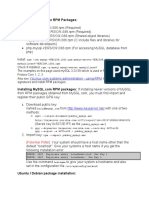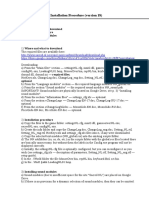0 ratings0% found this document useful (0 votes)
26 viewsMySQL Installation and Server Configurations Step by Step
The document provides steps to install and configure MySQL server on Red Hat Enterprise Linux 7. It outlines downloading and installing RPM packages in sequence. It also describes enabling and starting the MySQL service, securing it with mysql_secure_installation, and editing the my.cnf configuration file to configure properties like the data directory, port, and log settings. Finally, it shows how to use the Information_Schema to obtain metadata about databases and tables.
Uploaded by
Mercedez BenzCopyright
© © All Rights Reserved
Available Formats
Download as DOCX, PDF, TXT or read online on Scribd
0 ratings0% found this document useful (0 votes)
26 viewsMySQL Installation and Server Configurations Step by Step
The document provides steps to install and configure MySQL server on Red Hat Enterprise Linux 7. It outlines downloading and installing RPM packages in sequence. It also describes enabling and starting the MySQL service, securing it with mysql_secure_installation, and editing the my.cnf configuration file to configure properties like the data directory, port, and log settings. Finally, it shows how to use the Information_Schema to obtain metadata about databases and tables.
Uploaded by
Mercedez BenzCopyright
© © All Rights Reserved
Available Formats
Download as DOCX, PDF, TXT or read online on Scribd
You are on page 1/ 3
MySQL Installation and Server Configurations Step by Step
In my case operating system is RED HAT ENTERPRISE LINUX (7) and the version of Installed MySQL is
8.0.27
Installation of MySQL Step by Step:
All the Installation will be done through ROOT user
Before the installation you should remove extra plugins so there will be no chances of errors by
using this command
-> yum remove -y mariadb-libs
Untar the RPM bundle
->tar -xvf (File Name)
All the packages have been untarred. Important thing is All the rpm packages should be installed
in a sequence.
rpm -ivh mysql-community-common
rpm -ivh mysql-community-client-plugins
rpm -ivh mysql-community-libs
rpm -ivh mysql-community-libs-compat
rpm -ivh mysql-community-client
rpm -ivh mysql-community-server.8.0.27
To start mysql server
-> systemctl start mysqld
To enable mysql server
-> systemctl enable mysqld
To check the status of mysql either it is active or not
-> systemctl status mysqld
For the checking of temporary password:
-> cat /var/log/mysqld.log | grep password
Login through temporary password
-> mysql -uroot -p
-> (Enter temporary password)
Change the temporary password
-> alter user ‘root’@localhost’ identified by ‘Your New-Password’;
->exit
All the directories are in cat /etc/my.cnf
To secure MySQL Server Run:
/usr/bin/mysql_secure_installation
MySQL will ask five questions and the answers of these questions are following respectively
1) No 2)Yes 3)Yes 4)Yes 5)Yes
Test the configuration by using -> systemctl status mysqld and ->mysql -uroot -p
Installation of MySQL is done successfully.
#Edited by Faisal Hushaim
Configuration of MySQL Server Step by Step:
All the configuration will be done through Root user
Copy my.cnf file to root
-> cp /etc/my.cnf /root
Edit my.cnf file
-> vi /etc/my.cnf
Add the under given portion into the file
[mysqld]
datadir=/var/lib/mysql
socket=/var/lib/mysql/mysql.sock
port=3306
symbolic-links=0
general_log
log-bin=mybinlog
slow_query_log
[mysqld_safe]
log-error=/var/log/mysqld.log
pid-file=/var/run/mysqld/mysqld.pid
[client]
port=3306
Restart the service
->systemctl restart mysqld
#Edited by Faisal Hushaim
Obtaining Metadata Using Information Schema:
$ mysql -uroot -p(ur password)
Type the command select * from information_schema.schemata where
schema_name='database name'\G
Listing the number of tables, per storage engine, for each database by using a select statement with a
group by clause against the Tables table in the Information_Schema database.
You might also like
- Installing MySQL On Unix Linux Using Generic BinariesNo ratings yetInstalling MySQL On Unix Linux Using Generic Binaries6 pages
- Install MySQL Database Using Yum Group InstallNo ratings yetInstall MySQL Database Using Yum Group Install4 pages
- MX InfoStorage Installation InstructionsNo ratings yetMX InfoStorage Installation Instructions15 pages
- How To Install MySQL 8.0 On CentOS - RHEL 7 - 6 & Fedora 30 - 29 - TecAdminNo ratings yetHow To Install MySQL 8.0 On CentOS - RHEL 7 - 6 & Fedora 30 - 29 - TecAdmin4 pages
- Configure CACTI in CENTOS 7: Configuring YUM Server Through FTPNo ratings yetConfigure CACTI in CENTOS 7: Configuring YUM Server Through FTP3 pages
- Virtual Hosting With Proftpd and MySQL On Ubuntu 9.04No ratings yetVirtual Hosting With Proftpd and MySQL On Ubuntu 9.0411 pages
- Mysql Basic Tutorial: Code Corner Mysql StarterNo ratings yetMysql Basic Tutorial: Code Corner Mysql Starter13 pages
- Steps_for_an_Installation_of_MySQL_8_4_1734877849No ratings yetSteps_for_an_Installation_of_MySQL_8_4_17348778493 pages
- MySQL Administration & Configuration-Unit-2-Part-IINo ratings yetMySQL Administration & Configuration-Unit-2-Part-II27 pages
- Setting Up A Mysql Cluster Step by StepNo ratings yetSetting Up A Mysql Cluster Step by Step11 pages
- Zotero Data Server Installation ArchlinuxNo ratings yetZotero Data Server Installation Archlinux8 pages
- Create A Repositary For: RHCE QuestionsNo ratings yetCreate A Repositary For: RHCE Questions19 pages
- MYSQL DB and Employee Sample DB Setup : Narendra AllamNo ratings yetMYSQL DB and Employee Sample DB Setup : Narendra Allam3 pages
- Mysql Cluster Quick Start Guide - Windows: 1 Get The SoftwareNo ratings yetMysql Cluster Quick Start Guide - Windows: 1 Get The Software3 pages
- Mysql - Mariadb - ERROR 1698 (28000) - Access Denied For User Root-Localhost - Stack OverflowNo ratings yetMysql - Mariadb - ERROR 1698 (28000) - Access Denied For User Root-Localhost - Stack Overflow4 pages
- How To Install and Secure phpMyAdmin On Ubuntu 18No ratings yetHow To Install and Secure phpMyAdmin On Ubuntu 1810 pages
- Configuration of a Simple Samba File Server, Quota and Schedule BackupFrom EverandConfiguration of a Simple Samba File Server, Quota and Schedule BackupNo ratings yet
- Configuration of a Simple Samba File Server, Quota and Schedule BackupFrom EverandConfiguration of a Simple Samba File Server, Quota and Schedule BackupNo ratings yet
- Quick Configuration of Openldap and Kerberos In Linux and Authenicating Linux to Active DirectoryFrom EverandQuick Configuration of Openldap and Kerberos In Linux and Authenicating Linux to Active DirectoryNo ratings yet
- In My Case: Master - Slave Replication Step by Step100% (1)In My Case: Master - Slave Replication Step by Step4 pages
- Sacred NL Manual Installation Procedure (Version 18) : OptionalNo ratings yetSacred NL Manual Installation Procedure (Version 18) : Optional2 pages
- General Item Codes Item Base Id #: Console Command F04No ratings yetGeneral Item Codes Item Base Id #: Console Command F0413 pages
- Lightweight Portable Security (LPS) Public Edition (LPS-Public) User's GuideNo ratings yetLightweight Portable Security (LPS) Public Edition (LPS-Public) User's Guide57 pages
- 10.2.1.8 Lab - Create A Partition in WindowsNo ratings yet10.2.1.8 Lab - Create A Partition in Windows4 pages
- Downloaded From Manuals Search Engine: LT-2D3D User Manual v2.12 Edited: August 19, 2016No ratings yetDownloaded From Manuals Search Engine: LT-2D3D User Manual v2.12 Edited: August 19, 201650 pages
- Extensible File Allocation Table (ExFAT) AHTCC V1.1No ratings yetExtensible File Allocation Table (ExFAT) AHTCC V1.1117 pages
- Trust Is Good Control Is Better-Creating Secure Clouds by Continuous AuditingNo ratings yetTrust Is Good Control Is Better-Creating Secure Clouds by Continuous Auditing4 pages
- OpenShift - Container - Platform 4.6 OpenShift - Virtualization en USNo ratings yetOpenShift - Container - Platform 4.6 OpenShift - Virtualization en US257 pages
- FCL (Function Control List) File Programming Manual: 1. Maximum Number and Directory of FCL FilesNo ratings yetFCL (Function Control List) File Programming Manual: 1. Maximum Number and Directory of FCL Files4 pages
- User Guide - Pip 20.3.dev0 DocumentationNo ratings yetUser Guide - Pip 20.3.dev0 Documentation23 pages
- Motoman Advanced Robot Visual Interface Visual DCI User ManualNo ratings yetMotoman Advanced Robot Visual Interface Visual DCI User Manual62 pages
- Migration Guide From System Workbench To Stm32Cubeide: User ManualNo ratings yetMigration Guide From System Workbench To Stm32Cubeide: User Manual11 pages
- Getting Familiar With DOS (Disk Operating System) : Practical No. 03No ratings yetGetting Familiar With DOS (Disk Operating System) : Practical No. 034 pages





























































































